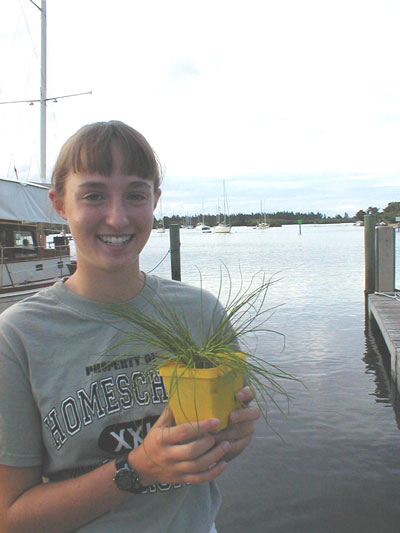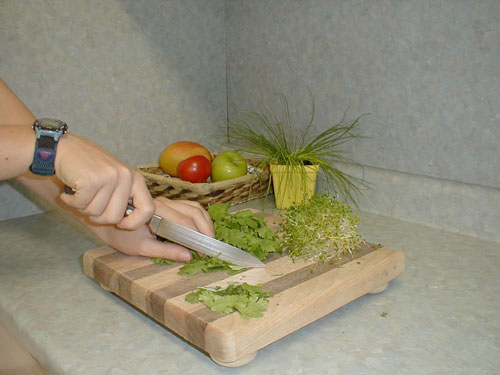
Favorite Galley Tips from Out Of Bounds
by Barb Theisen
Fast food? Air-conditioned supermarkets with shelves stocked
high? Sorry, they’re few and far between in a cruiser’s paradise. But with a few
tips – and the fact that you’re in PARADISE - you won’t miss much.

The Fresh Taste of Sprouts
Want to add fresh taste and crunch to your meals when it’s been weeks since
you’ve seen a fresh vegetable? Grow your own sprouts right on board your boat.
Sprouts are tasty, nutritious, inexpensive and easy to grow. Sprouts need very
little space. All that is required to produce sprouts is seeds, a sprouting jar,
moisture, warmth, darkness and a few minutes of your time every day.
When purchasing seeds for sprouting, be sure to get seeds that have not been
treated with a fungicide, insecticide or any other material. This type of seed
is available at health food stores, many supermarkets or by mail order. Popular
sprouting seeds include alfalfa, mung, radish, wheat, broccoli, clover and
buckwheat, although there are dozens more varieties. Each has its own unique
flavor.
To grow sprouts, begin with a clean, wide-mouth quart jar. Cover the mouth of
the jar with cheesecloth or a nylon stocking and secure with a rubber band or
screw-top ring, or use a commercially available screw-top sprouting lid. These
lids are available, along with several types of sprouting jars from
http://www.sproutpeople.com/index.html. You must use a lid that permits air
to move in and out of the jar.
Cover the bottom of the jar with the desired amount of seed, generally not more
than 1/4 cup. Depending on the type of seed that is used, only one to two
tablespoons may be required. Soak the seeds for 8-12 hours in a volume of water
at least double that of the seeds. This will soften the seed coat for sprouting.
After soaking, drain off the water and rinse the seeds. After the rinse water
has been drained off, invert the jar and prop it at an angle with seeds
distributed evenly along the side of the jar. By placing the jar at an angle,
the sprouts will have good drainage and air circulation. Keep the jar out of
direct sunlight, preferably in a dark place.
Continue to rinse the sprouts twice a day until they have grown to the desired
length. Always be sure excess water is drained off the sprouts; if the sprouts
remain in the water they could ferment and spoil. You can use the excess rinse
water to water other plants you may have aboard.
Most sprouts will take two to five days to grow to their optimum size. Use fresh
sprouts on salads, in sandwiches, or wrapped in tortillas with tacos, burritos
or quesadillas. Sprouts may be kept for one to two weeks in the refrigerator if
kept in a sealed container but your best bet is to grow what you need for a day
or two and use a couple of sprouting jars for a continual harvest and for a
variety of flavors.
Sprouts are a great source of minerals and vitamins, particularly vitamins B1,
B2, and C. and can add that fresh taste you’ve been craving.

Tis the Seasoning
The right herbs and seasonings can make any meal a gourmet’s delight. They
become the ultimate chef’s secret weapon when cruising as they can add zest or
zing to canned provisions, add new life to leftovers, or create a fresh taste to
fresh fish ….again.
Grow Your Own
Fresh herbs offer the best taste. Growing small containers of herbs on board
your boat is very easy to do and allows you to snip off the herbs, as you need
them. Most herbs require only a small amount of water and sunlight. Take them up
on deck occasionally for extra sunlight, if needed. If you grow fresh sprouts,
use the sprout rinse water to water your herbs.
Storing Fresh Herbs
Fresh herbs need to be kept moist and cool. Try layering them between damp paper
towels and keep them in the refrigerator. When refrigerating fresh herbs, never
seal them in plastic bags or they will become slimy. Try to use fresh herbs as
quickly as possible. At most, they will keep no more than two weeks.
Storing Dried Herbs
Store dried herbs in tightly sealed containers and keep in a cool, dark place.
Most spice racks are not ideal locations for storing dried herbs and seasonings.
Sunlight and heat will quickly lesson the flavor of spices. Most seasonings will
stay fresh for about six months. After that, there is usually a loss of flavor.
Sniff your seasonings to check on freshness. If the aroma is strong, the spice
is probably still good. If the smell is much fainter than it should be, your
seasoning is stale.
Cooking with Herbs
It is usually best to add fresh herbs near the end of cooking time. Fresh herbs
especially, can easily be overcooked. However some herbs such as bay leaves,
thyme and rosemary should be added earlier. Their flavors increase with cooking.
If using dried herbs, try adding about half the amount of herbs at the beginning
of the cooking process and then add the rest at the end.
When substituting fresh herbs for dried herbs, remember you will need to use
about three times what the recipe calls for.
An herb’s flavor comes from the oils, which are released after the herb is
crushed or crumbled. The best way to crush an herb is with a mortar and pestle
or even crumbling between your fingers. Cutting with a knife just leaves the
flavorful oils on the cutting board.
A pepper mill to grind peppercorns is a great addition to the galley. Seasonings
take up very little space on a boat but can add so much to improving the
cruising life.
Storing Eggs and Egg Substitutions
Eggs are an inexpensive source of protein and can be used in a variety of ways.
They are generally easy to find in most ports. However it’s a good idea to stock
up on eggs if you’re going to be spending some time anchored in paradise and
don’t want to worry about needing to make a provisioning stop. Although there
are a variety of ways to “preserve” eggs such as coating with Vaseline or
boiling briefly, there is an easier way. The simplest way I have found to extend
the storage time of eggs is to buy fresh, unrefrigerated eggs and store right in
their cartons. Do not wash the eggs as they already have a protective coat
sealing them. Twice a week, turn your cartons over. You can designate Mondays
and Thursdays (or whatever) as egg turning day. The eggs should stay fresh for
several months. Remember to save your egg cartons, as you may need to reuse
them.
Dry egg powder or egg white powder makes an excellent replacement for fresh eggs
in baking. This is available in a can in the baking section of large
supermarkets. It stores easily.
Alternately, if you’re running low on eggs, here are a few items that may work
as egg replacements.
If your baked goods – such as muffins, quick breads or cookies - call for eggs
try replacing one egg with Half of a ripe banana, mashed
¼ cup of applesauce
¼ cup of pureed prunes
¼ cup canned pumpkin
1 heaping Tablespoon of soy flour plus 1 tablespoon of water
In a casseroles or meatloaves try replacing one egg with:
·3 tablespoons of tomato paste
·3 tablespoons of mashed potatoes
Buying and Storing Butter
You can buy delicious canned butter that needs no refrigeration. Great bets are
canned butter from New Zealand or Ireland. You’ll find canned butter available
in many ports around the world although it is difficult to find in the US.
Whipped margarine in plastic tubs will stay fresh for several months if left
unopened. Butter flavored Crisco works great for many baking recipes and needs
no refrigeration.
You can also save money by preserving your own butter.
HOW TO CAN BUTTER:
• Use only highest quality butter Land O Lakes or equivalent).
• Heat jelly jars in 250-degree oven for 20 minutes, without rings or seals.
• While jars heat, melt butter slowly until it comes to a boil. Reduce heat,
cover and simmer for 5 minutes.
• Pour melted butter carefully into heated jars, being careful not to get any
butter on rim of jar.
• Add lid and ring and close securely. They will seal as they cool. Shake jars a
few times during cooling to prevent separation, although this step is optional.
• Put into refrigerator or other cool place until butter hardens. After
hardening, butter will store for 3 years.
Sugar Substitutions
Running low on sugar when the nearest grocery store is a two-day sail away? Try
one of the following sugar substitutions. The following may be substituted for 1
Cup of Sugar:
1/2 Cup firmly packed brown sugar
1 1/2 Cups Molasses
2 Cups Corn Syrup
3/4 Cups Honey
1 1/2 Cups Maple Syrup
Note: You will need to reduce the liquid in the recipe to compensate for the
liquid in the molasses, corn syrup, honey and syrup.

Pop Up a Snack
Popcorn is the greatest cruising snack around (at least according to this
cruising mom). Easy to store. Takes up very little room. Can’t be crushed. Has a
very long shelf life. Inexpensive. Low fat (until you add the butter). Feeds a
crowd of kids or can be taken to a sundowner party. So be sure to stock up on
some popcorn.
Some great popcorn toppings include Parmesan cheese, garlic salt, Cajun
seasoning, cinnamon sugar, a combination of Italian seasonings and chili powder.
Experiment with others!
Easy Caramel Corn
1/2-cup butter
1/2-cup brown sugar, firmly packed
3 quarts popped popcorn
Cream butter; add brown sugar and whip until fluffy. In a large baking pan,
combine popcorn. Mix in creamed mixture. Bake in 350-degree oven for about 8
minutes or until crisp. Serve warm if desired.
Did you know that kernels that don’t pop are called “old maids?” They don’t pop
because they don’t have a sufficient amount of water contained within the starch
to create the build up of pressure needed to pop the kernels.
If your popcorn does not pop into fluffy, crunchy kernels, it may have lost some
of its moisture. Rejuvenate popcorn by filling a 1-quart jar 3/4 full with
popcorn. Add one tablespoon of water. Cover and shake every five to 10 minutes
until all the water is absorbed. In two to four days it should be perfect for
popping.
Barbara Theisen has spent the past ten years living aboard Out of Bounds with
her husband Tom and daughters, Kate and Kenna. For more information on living
the cruising life visit the Theisen’s Website at
www.TheCruisingLife.com .